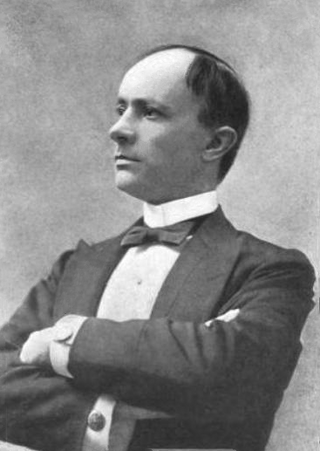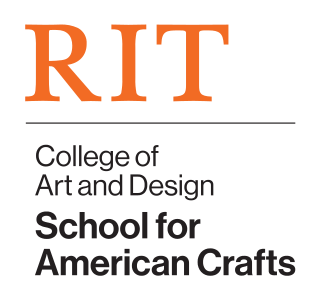Related Research Articles

Eero Saarinen was a Finnish-American architect and industrial designer who created a wide array of innovative designs for buildings and monuments, including the General Motors Technical Center in Warren, Michigan; the passenger terminal at Dulles International Airport outside Washington, D.C.; the TWA Flight Center at John F. Kennedy International Airport; and the Gateway Arch in St. Louis. He was the son of Finnish architect Eliel Saarinen.

Charles Rohlfs, was an American actor, patternmaker, stove designer and furniture maker. Rohlfs is a representative of the Arts and Crafts Movement, and is most famous for his skill as a furniture designer and maker.

Shaker furniture is a distinctive style of furniture developed by the United Society of Believers in Christ's Second Appearing, commonly known as Shakers, a religious sect that had guiding principles of simplicity, utility and honesty. Their beliefs were reflected in the well-made furniture of minimalist designs.

George Katsutoshi Nakashima was an American woodworker, architect, and furniture maker who was one of the leading innovators of 20th century furniture design and a father of the American craft movement. In 1983, he accepted the Order of the Sacred Treasure, an honor bestowed by the Emperor of Japan and the Japanese government.
Tage Frid was a Danish-born woodworker, educator and author who influenced the development of the studio furniture movement in the United States. His design work was often in the Danish-modern style, best known for his three legged stool and his publications.

Sam Maloof was an American furniture designer and woodworker. Maloof's work is in the collections of several major American museums, including the Metropolitan Museum of Art, the Los Angeles County Museum of Art, the Philadelphia Museum of Art, and the Smithsonian American Art Museum. Maloof, the first craftsman to receive a MacArthur fellowship, was described by The New York Times as "a central figure in the postwar American crafts movement".

Wendell Castle was an American sculptor and furniture maker and an important figure in late 20th century American craft. He has been referred to as the "father of the art furniture movement" and included in the "Big 4" of modern woodworking with Wharton Esherick, George Nakashima, and Sam Maloof.
Mark Lindquist is an American sculptor in wood, artist, author, and photographer. Lindquist is a major figure in the redirection and resurgence of woodturning in the United States beginning in the early 1970s. His communication of his ideas through teaching, writing, and exhibiting, has resulted in many of his pioneering aesthetics and techniques becoming common practice. In the exhibition catalog for a 1995 retrospective of Lindquist's works at the Renwick Gallery of the Smithsonian American Art Museum, his contributions to woodturning and wood sculpture are described as "so profound and far-reaching that they have reconstituted the field". He has often been credited with being the first turner to synthesize the disparate and diverse influences of the craft field with that of the fine arts world.
Jere Osgood was an American studio furniture maker, and teacher of furniture and woodworking. He taught for many years in the Boston University Program in Artisanry.
JB Blunk (1926–2002) was a sculptor who worked primarily in wood and clay. In addition to the pieces he produced in wood and ceramics, Blunk worked in other media, including jewelry, furniture, painting, bronze, and stone.
Charles Radtke is a studio furniture maker working in Cedarburg, Wisconsin. His focus is design, rarely if ever repeating an object. His work is found primarily in private collections, with the exception of his Sarcophagus #1 residing in permanent collection in the Renwick Gallery of the Smithsonian Art Museum in Washington, DC and in the Museum of Fine Arts in Boston. The piece that is part of the collection in Boston, is on display at Milwaukee Art Museum, April 19, 2019 – August 25, 2019 as part of his exhibition: Charles Radtke: Contained.

Rosanne Somerson is an American-born woodworker, furniture designer/maker, educator, and former President of Rhode Island School of Design (RISD). An artist connected with the early years of the Studio Furniture, her work and career have been influential to the field.

Jonathan Gostelowe was an 18th-century American cabinetmaker, best remembered for his Philadelphia Chippendale-style furniture.
Arthur Espenet Carpenter was a master woodworker and furniture maker in Bolinas, California known for his wishbone chair and desk with scalloped seashell sides. Self-taught, he joined the Baulines Craft Guild. He also taught had apprentices. His work is in the collection of the Smithsonian Institution and has been exhibited in The Museum of Modern Art and The Museum of Arts and Design in New York. He was declared a “living California treasure” in 1984. He received The Furniture Society's Award of Distinction in 2001.
Jacob Cress, better known as Jake Cress, is a furniture maker in Fincastle, Virginia who is known for his interpretations of classical 18th century furniture. He considers himself to be a cabinet maker and not an artist. He also builds normal classical furniture, miniature furniture, and carves boxes, as well as decorative pieces. He also restores furniture. Additionally, he builds more modern pieces like country tables and desks. Cress works with mahogany, walnut, and cherry woods. His animated works include "The Decorator," "Alladin's Lamp," "Hickory Dickory Dock Clock," "Self-Portrait," and "Clock Face." Cress crafts each piece of furniture by hand in his shop without sketching the furniture before he begins working on it.

Norm Sartorius is an American woodworker who carves fine art spoons in many styles including natural, biomorphic, abstract, symbolic, ethnic, and ceremonial. His works are in the permanent collections of the Smithsonian American Art Museum's Renwick Gallery, the Yale University Art Gallery, the Philadelphia Museum of Art, and other public and private collections. He is a frequent participant in woodworking and craft shows in America, and won the Award of Excellence in Wood at the 2015 American Craft Council show in Baltimore and the 2015 Smithsonian Craft Show in Washington, DC. Since 2008, he has co-directed a grant-funded research project on the life, work, and legacy of American woodworker Emil Milan.
Wendy Maruyama is an American visual artist, furniture maker, and educator from California. She was born in La Junta, Colorado.
Judy Kensley McKie is an American artist, furniture designer, and furniture maker. She has been making her signature style of furniture with carved and embellished animal and plant motifs since 1977. She is based in Boston, Massachusetts.
Mira Nakashima-Yarnall is an architect and furniture maker. She is the daughter of George Nakashima and is now the President and Creative Director for George Nakashima, Woodworker.

The School for American Crafts was founded by Aileen Osborn Webb and the American Craftsmen's Council (ACC) in the 1940s. It sought to provide training in traditional crafts and "to develop and raise the standards of the hand arts in the United States."
References
- 1 2 "A Landscape Full of Stories: Robert Erickson". North Columbia Schoolhouse Cultural Center. Retrieved 5 March 2014.
- 1 2 3 Desmith, Christy (Aug–Sep 2012). "Chair Master". American Craft Magazine. Retrieved 5 March 2014.
- ↑ Fisher, Marshall Jon (April 2001). "Design: The Ergonomic Rocking Chair". The Atlantic. Retrieved 5 March 2014.
- ↑ Binzen, Jon (November 29, 2012). "Robert Erickson's Chairs: Angle of Repose". Fine Woodworking. Retrieved 5 March 2014.
- ↑ "Chair Man of the Boards: Robert Erickson". Woodworker's Journal. 2000-05-23. Archived from the original on 6 March 2014. Retrieved 5 March 2014.
- ↑ Thomas, Laura (April 25, 2007). "Hot Stuff, West Bay". San Francisco Chronicle. Retrieved 5 March 2014.
- ↑ "Floating Back Rocker". Smithsonian American Art Museum. Retrieved 5 March 2014.
- ↑ "Van Muyden Chair". Yale University Art Gallery. Retrieved 5 March 2014.
- ↑ "Van Muyden Chair". Los Angeles County Museum of Art. Retrieved 5 March 2014.